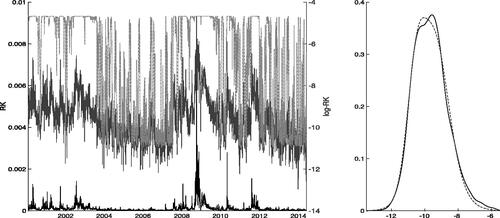Figures & data
Figure 1. Left panel: Daily (lower solid) and
(upper solid), and mixing weights based on the estimates of the StMAR(4,2) model in (dot-dash) for the
series. The mixing weights
are scaled from
to
Right panel: A kernel density estimate of the
observations (solid), and the mixture density (dashes) implied by the same StMAR model as in the left panel.

Table 1. Parameter estimates for three selected StMAR models and the data over the period 3 January 2000–3 June 2014.
Table 2. The percentage shares of cumulative realized kernel observations that belong to the 99%, 95% and 90% one-sided upper prediction intervals based on the distribution of 1,000,000 simulated conditional sample paths.
